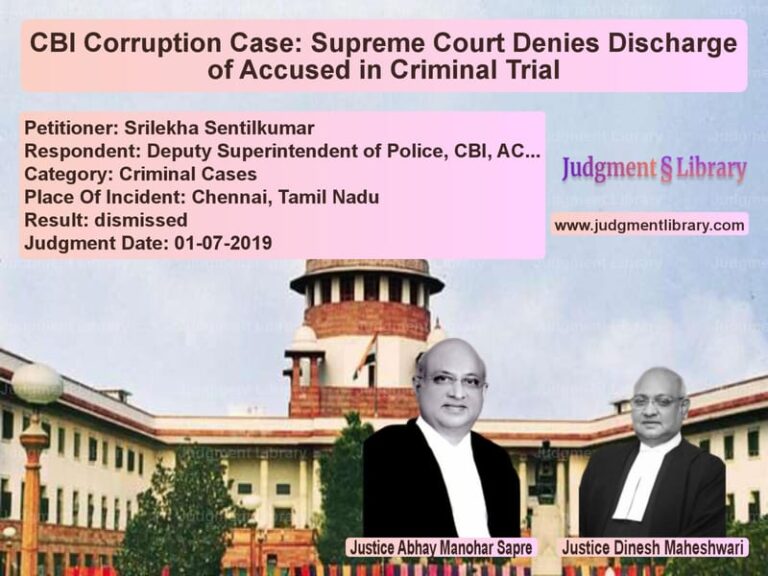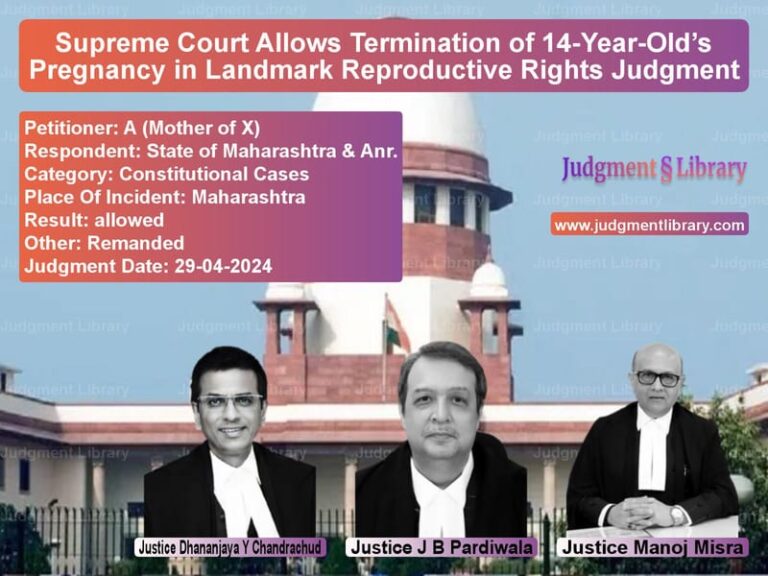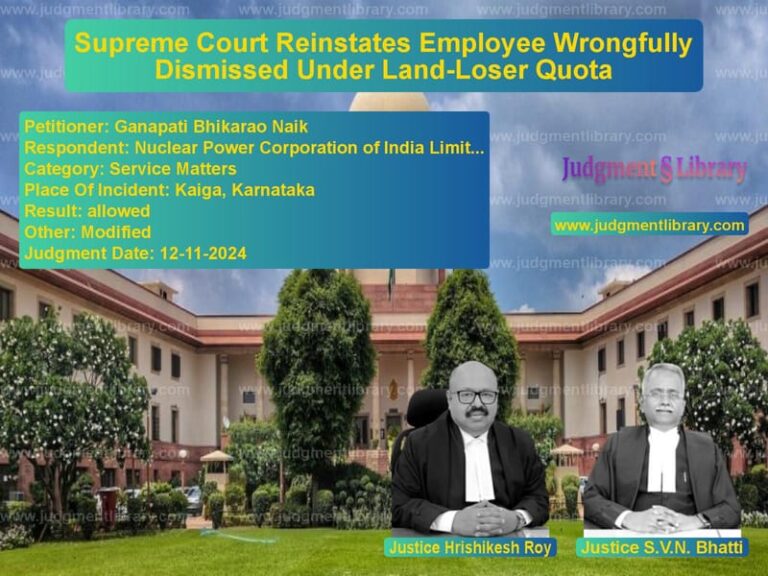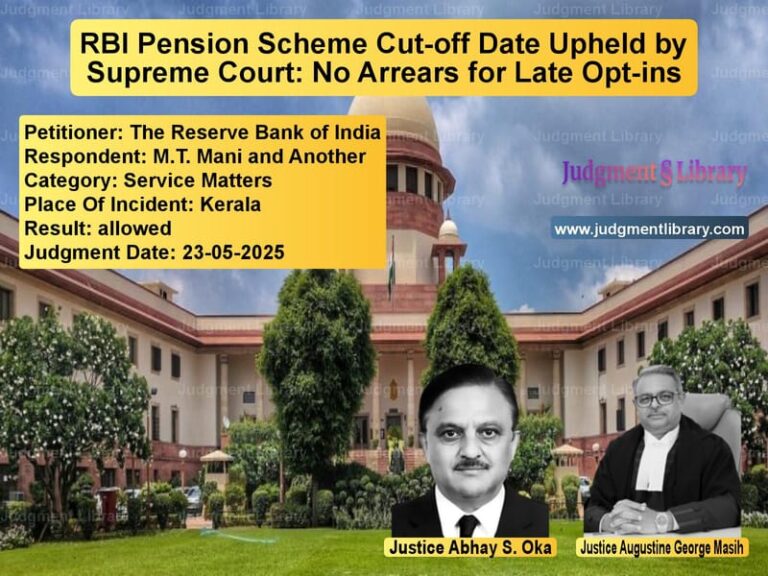Supreme Court Rules on Partition Rights: Landmark Judgment on Family Property Dispute
The case of Subraya M.N. vs. Vittala M.N. & Ors. is a landmark ruling by the Supreme Court of India regarding the partition of ancestral property among family members. The dispute revolved around whether certain properties belonged to the joint family or were self-acquired by one of the members. The Supreme Court, in its final ruling, settled key legal principles governing partition suits and family property disputes under Hindu law.
Background of the Case
The case originated as a partition suit filed by the respondents (plaintiffs) against the appellant (defendant), claiming their rightful share in the family’s ancestral property. The suit properties included agricultural lands and a house.
The dispute arose after the defendant allegedly attempted to claim exclusive ownership over certain properties, arguing that they were self-acquired. The plaintiffs, however, contended that these properties were acquired using joint family funds and thus should be equally divided among all family members.
Legal Issues Raised
- Whether the properties in question were self-acquired or part of the joint family estate?
- Whether the plaintiffs had legally relinquished their share in the property?
- Whether the defendant’s claim of acquiring land through government grant invalidated the plaintiffs’ claims?
- What is the role of panchayat settlements in family property disputes?
Arguments of the Appellant (Defendant)
The appellant, Subraya M.N., contended:
- That certain properties, including item No.3, were granted to him by the government and thus were his self-acquired properties.
- That a panchayat resolution in 1995 had settled the dispute, where the plaintiffs agreed to receive ₹50,000 each in exchange for relinquishing their share.
- That documents and oral evidence proved that he alone had cultivated and developed certain lands, and thus they were his.
Arguments of the Respondents (Plaintiffs)
The respondents, Vittala M.N. and others, countered:
- That the properties were originally owned by their father, late Narayana, making them part of the joint family estate.
- That they had contributed to the family income while working in the army, which was used to develop the land.
- That the panchayat resolution did not constitute a legally binding agreement under the Registration Act.
Supreme Court’s Observations
The Supreme Court analyzed the evidence presented and made the following key observations:
- “A family settlement recorded in writing must be registered. If not registered, it cannot operate as a transfer of property.”
- “For a property to be classified as self-acquired, the claimant must provide conclusive proof that it was purchased or developed independently.”
- “Panchayat resolutions, though evidentiary, cannot override the legal requirement of a registered document for relinquishment of rights.”
Key Extracts from the Judgment
The Supreme Court ruled:
“The statutory protection granted to co-parceners under Hindu law ensures that no individual member can claim exclusive ownership over joint family properties without clear proof of independent acquisition.”
The Court further held:
“The defendant failed to establish that item No.3 was his self-acquired property. The patta granted by the government was in recognition of family possession, and not as an independent acquisition.”
Final Judgment
The Supreme Court made the following rulings:
- The appeal by Subraya M.N. was partially allowed.
- The claim over items No.1 and 2 was rejected, ruling that the plaintiffs had relinquished their rights.
- The court held that item No.3 remained joint family property, granting each family member a 1/5th share.
- The parties were directed to approach the trial court for final division of shares.
Impact of the Judgment
This ruling has significant legal implications:
- It reaffirms the importance of formal legal documentation in family property settlements.
- It establishes that government grants can be considered joint family property unless proven otherwise.
- It clarifies that oral panchayat agreements have limited legal value without formal registration.
- It provides guidance on how courts should evaluate self-acquired property claims.
Conclusion
The Supreme Court’s decision in Subraya M.N. vs. Vittala M.N. & Ors. serves as an important precedent for partition disputes. It underscores that family members cannot be deprived of their rightful share in ancestral property without due legal process. By balancing legal formalities with principles of equity, the ruling ensures that property disputes are resolved fairly and in accordance with established legal principles.
Don’t miss out on the full details! Download the complete judgment in PDF format below and gain valuable insights instantly!
Download Judgment: Subraya M.N. vs Vittala M.N. & Ors. Supreme Court of India Judgment Dated 05-07-2016-1741873106158.pdf
Direct Downlaod Judgment: Direct downlaod this Judgment
See all petitions in Property Disputes
See all petitions in Judgment by R. Banumathi
See all petitions in Judgment by Kurian Joseph
See all petitions in partially allowed
See all petitions in Modified
See all petitions in supreme court of India judgments July 2016
See all petitions in 2016 judgments
See all posts in Civil Cases Category
See all allowed petitions in Civil Cases Category
See all Dismissed petitions in Civil Cases Category
See all partially allowed petitions in Civil Cases Category







